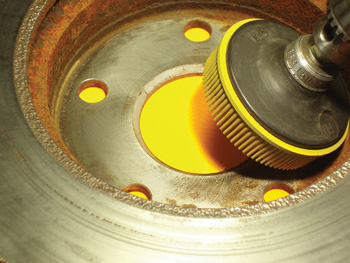As a general rule of thumb, the run-out or “wobble” on a brake rotor’s friction surfaces should never exceed .010 inches, nor should the more critical thickness variation exceed .0005 inches, which is less than 1/6th the thickness of this page. Most recently, the relevance of brake rotor specifications became apparent when two brake rotors that I had turned for a local shop came back with a low-speed brake shimmy complaint. I suspected the rotors might have a problem in the hub area. The technician had jarred the badly rusted rotors loose with some very hard hammer blows to the rotors’ hub surfaces. Measuring the distortion at each rotor hub took some time and ingenuity, but I discovered that the hammer blows had indeed distorted the rotor mounting surface on one rotor, which in turn distorted the rotor friction surfaces after the wheels and rotor were torqued to the wheel bearing hub assembly.

Rotor Economics
While the above case study is a relatively rare occurrence, it illustrates why clean and distortion-free mounting surfaces at the hub/rotor interface are required for good brake rotor performance. If the technician had initially recommended new rotors, the problem might have been avoided altogether. On a more economic level, replacements can also be justified, thanks to modern rotors having less available machinable stock for resurfacing. The narrowing gap between the labor involved with resurfacing old rotors and the cost of new replacement rotors is causing more shops to sell their brake lathes and delegate the resurfacing of larger, more expensive rotors to specialized local jobbers and automotive machine shops.
Rotor Types
In most cases, the rotors on older vehicles are cast as a rotor/hub assembly. On modern vehicles, the rotor is usually a separate “hat” configuration that clamps between the wheel and wheel bearing hub assembly. The hat-type rotor can also be of a composite design with a sheet metal hub welded to a cast-iron friction surface. Due to run-out problems created by the lightweight sheet metal hubs, most shops opt to replace with one-piece cast units. Rotors can also be vented or non-vented, with vented rotors most often used on heavier domestic vehicles and non-vented rotors most often used on lighter import vehicles. Some rear disc rotors also have provisions for an internal drum-type park brake mechanism.
Selling New Rotors
As with brake friction, parts professionals are often faced with selling “good,” “better” or “best” brake rotors. The low-end rotor generally won’t be designed with the same number and configuration of cooling fins nor with the same quality materials as the high-end OE-style replacement rotor. The high-end rotor tends to duplicate the OE configuration and also tends to produce less noise and pedal pulsation complaints. Since warranty comebacks are an issue for any repair shop owner, it’s always better to initially recommend the premium-grade rotor.
Performance rotors are a completely separate market. On the upside, most performance rotors have vent holes drilled or vent slots cast into the friction surface designed to channel frictional gases and water contamination away from the brake pad surface. On the downside, these holes and slots in the friction surface tend to wear brake pads more rapidly than does the premium standard rotor. Remember also brake squeal can be a normal condition when using performance brake pads and rotors.
Brake Drums
While less complicated than brake rotors, drums can also have either a cast or composite hub surface. In either case, the drum must fit snugly on the axle hub. In general, maximum stock removal for most passenger vehicle drums is .060-inch or less while light truck drums 12-inch or more in diameter can accommodate .090-inch of stock removal unless otherwise stated. Third, care must be taken to avoid knocking a new or resurfaced brake drum out-of-round. Last, most drum brakes will create a temporary noise complaint in wet climates, which will usually disappear with use.













